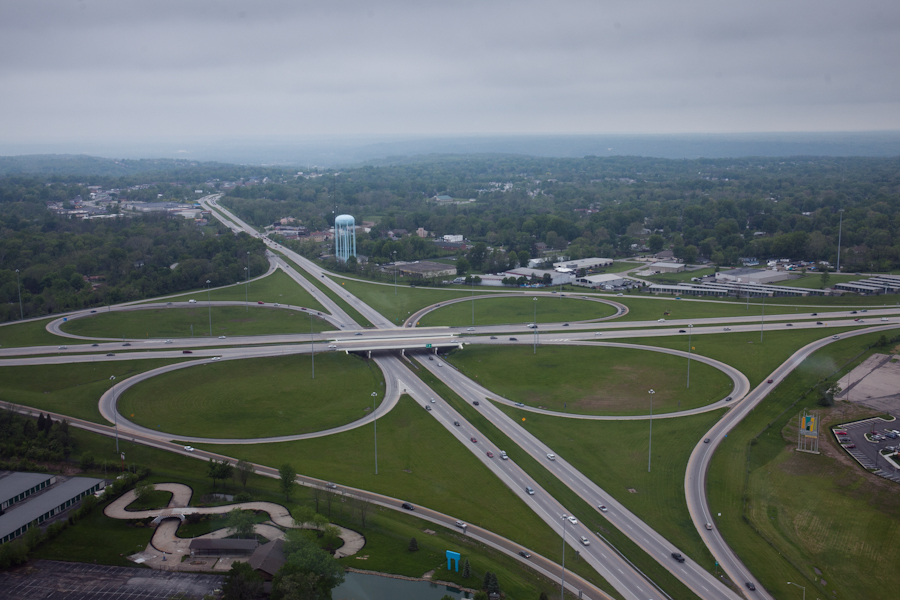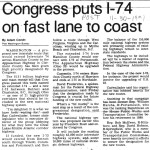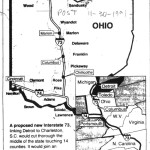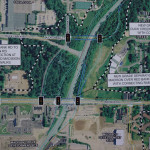The Eastern Corridor Program has been part of Cincinnati’s political landscape since 1999. That year the Ohio, Kentucky, Indiana Regional Council of Governments (OKI) completed a Major Investment Study that envisioned construction of a new expressway between I-71 and I-275 and commuter rail service on existing freight railroad tracks as a multi-modal solution to limited east-west travel in eastern Hamilton County.
But are the incremental upgrades planned for Red Bank Road that appeared in the Ohio Department of Transportation’s (ODOT) December 21, 2013 Preferred Alternative Implementation Plan part of a long-term plan to extend Interstate 74 across Hamilton County and east to Portsmouth, OH?
A veteran of Cincinnati transportation planning thinks so. Speaking on terms of anonymity, a source claims that he was approached in the mid-1990s by Hamilton County officials and out-of-state toll road builders who sought to extend I-74 from its current terminus in Cincinnati at I-75 to SR 32 in Clermont County.
According to the individual, the Eastern Corridor Program charts a different route for I-74 across Hamilton County but it achieves a similar end. Specifically, it aims to open eastern Hamilton County and Clermont County to development in a way that interstate-quality upgrades to SR 32 east of I-275 could not alone achieve.
Extension of I-74 east to Portsmouth was widely discussed in the Cincinnati media in the early 1990s. On November 11, 1991, The Cincinnati Post reported that the newly passed Intermodal Surface Transportation Efficiency Act of 1991 named “an extended I-74 – and a new I-73 between Detroit and Charleston, SC, through Ohio – as one of 21 high-priority corridors”.
Planning for new sections of I-74 began in the early 1990s in North Carolina, and today 122 miles of I-74 are now open in that state.
While ODOT has never explicitly studied an I-74 extension, it did begin planning I-73 immediately after passage of the highway bill. This planning took place in an unorthodox manner when, in 1991, former Ohio Governor George Voinovich (R) directed the Ohio Turnpike Commission (OTC) – not ODOT – to study construction of a new interstate highway connecting Toledo, Columbus and Portsmouth.
An 80% toll hike in 1995 raised suspicions that construction of I-73 was imminent, however the OTC ended its planning 1997. This event appears to have coincided with West Virginia’s decision to slowly build its section of I-73/74 as a public/private partnership with various coal companies. With the end of I-73 planning also went any expectation that SR 32 might soon be upgraded to I-74 between Cincinnati and Portsmouth.
Since the conclusion of the Ohio Turnpike Commission’s study in 1997, ODOT has not explicitly planned for I-73 or the I-74 extension. However, many of its recent activities are consistent with the OTC’s plans in the 1990s.
On July 22, 2013 Governor John Kasich (R) announced that excess Ohio Turnpike toll revenue will fund construction of the $450 million Portsmouth Bypass, which was part of the Ohio Turnpike Commission’s 1990’s-era I-73 study, and is a critical link in the national I-73/I-74 plan. To be initially signed as SR 823, the Portsmouth Bypass will be a fully grade-separated and access-controlled highway – an interstate highway in everything but name.
No mention of I-73 or an I-74 extension appears on ODOT’s website; but an October 12, 2010 post on the National I-73/I-74 Association’s website named Steven Carter, Director of Scioto County (Portsmouth) Economic Development, as well as two officials from the Toledo area, as attendees at the association’s fall 2010 “Road Rally” in Washington, D.C.
Near Cincinnati, improvements to SR 32 are bringing the roadway closer to Interstate Highway design specifications. A new $32 million interchange is under construction at I-275, and the Clermont County Transportation Improvement District is studying full grade separation and controlled access from Batavia to the Brown County Line.
Within Hamilton County, ODOT divided a possible I-74 route into two separate projects: SR 32 Relocation and Red Bank Road upgrades. At an August 2011 public meeting, ODOT displayed drawings of Red Bank Road reconstructed as a fully grade separated and access controlled expressway. Those drawings do not currently appear on the project’s website.
New drawings shown at ODOT’s Oct 2, 2013 meeting and in its December 21, 2013 report are less ambitious but do not preclude a future full conversion of Red Bank Road into an interstate highway.
The project website states that the relocated SR 32 will “feel like a boulevard or parkway…it will not be a highway like I-71 or I-75”. However, no design feature presented to-date by ODOT prevents relocated SR 32 from being improved to full grade separation and limited access. In the meantime, planning and promotional activities for the future I-74 connecting the Midwest with the coastal Carolinas continue in earnest.
Editorial Note: In the coming weeks, we will publish two follow-up stories related to the Eastern Corridor Program. The first will take an in-depth look at the Portsmouth Bypass and West Virginia portion of the I-74 extension, and the second will provide an updated look at the program’s proposed Oasis Commuter Rail line.






